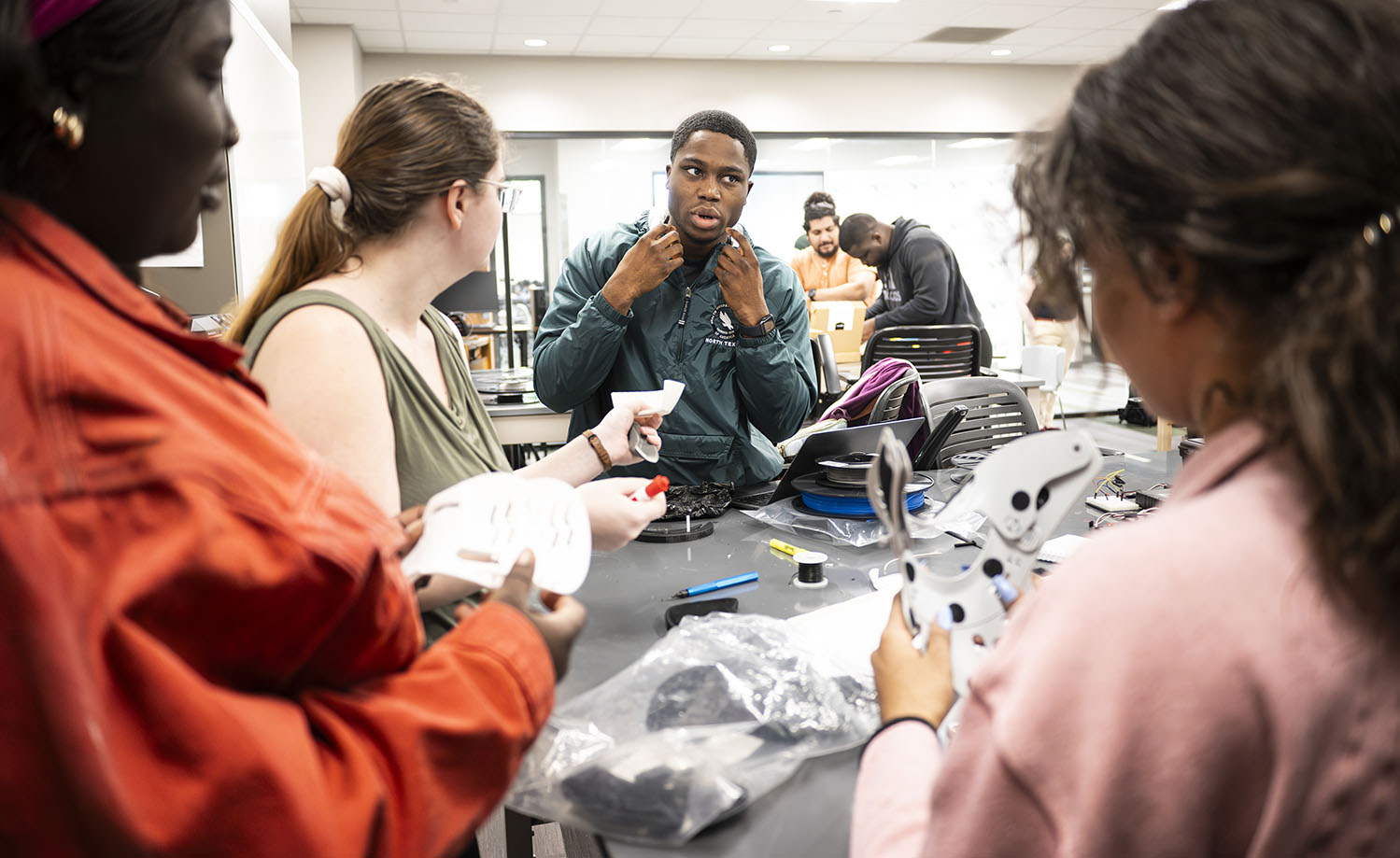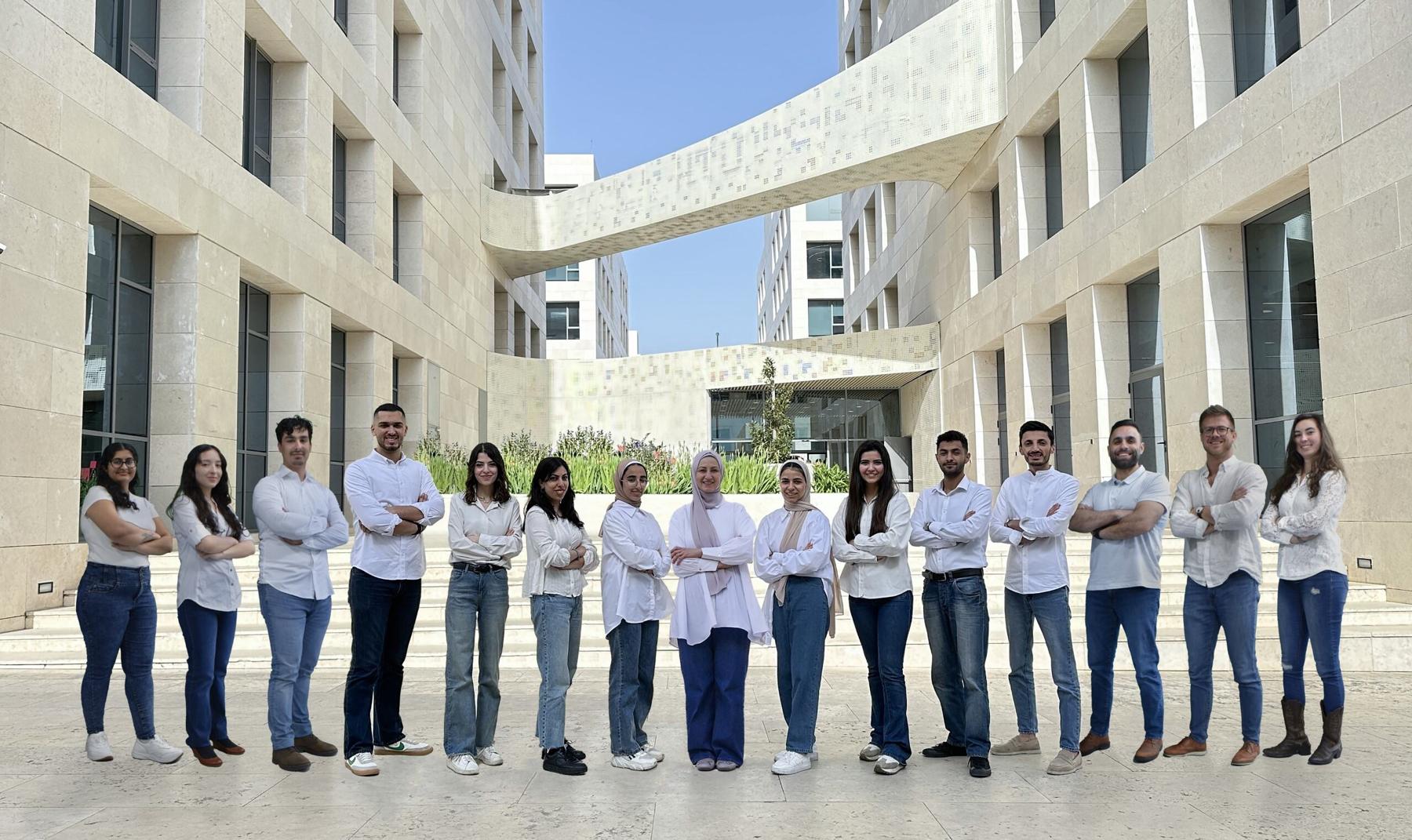Students in the University of North Texas College of Engineering showed off their collaboration skills at home and globally.
In April, 93 teams of senior undergraduate engineering students presented their capstone projects as part of the college’s North Texas Design biannual event. Over this academic year, the teams of three or more were tasked with addressing a real-world problem while developing the skills they’ll need in a professional setting such as communication and presentation. The project is part of the senior engineering capstone course required for all undergraduates.
“Design day is one of our favorite days in the College of Engineering,” says Dean Paul Krueger. “Our students get to showcase everything they’ve learned, from theory to practice, during their time at UNT with a hands-on project on a topic they care about.”
Spring projects ranged from updating medical devices to creating a sustainable village. Learn more about a few of the innovative student solutions below.
Biomedical Engineering

When a person experiences a traumatic injury to their neck, doctors will have them wear a cervical collar, or neck brace, until they begin physical therapy. This process usually takes around 12 weeks, which the team behind the “Lazy Susan” cervical collar says can be a detriment to patients.
“Usually what happens is the patients experience muscle loss and range of motion in their necks,” says team member Amanda Miller. “Our collar would let patients begin moving earlier, at the behest of their doctor, to prevent those losses.”
The four-member team was made up of Miller, Victor Kajopelaye, Jade Salser and Oluwafeyikemi Alli. They were sponsored by ManaMed, a medical equipment manufacturer in Denton, and used ManaMed’s EZ80 cervical collar as a base for their project.
Where the chin rest would normally connect with the rest of the front plate, they created a turning mechanism that would allow a patient to turn their head horizontally up to 60 degrees. The mechanism has locking slots that go up by 10 degrees, allowing a doctor to slowly let a patient work their way up to using their neck again. Rubber bands of different strengths attached to the device would offer resistance to help re-train the muscles.
ManaMed will continue to develop the product alongside an orthopedic surgeon. While the prototype was created with a 3D printer, ManaMed will look to make the finished product out of a more durable thermoplastic before beginning patient trials of the collar.
Computer Science and Engineering
One team went global by uniting with students from the University of Maryland on a project for the NASA Goddard (GSFC) Ocean communication team. The teams helped create interactive artwork featuring imaging from NASA’s PACE Satellite Mission. PACE collects images of the ocean to further study ocean biology, aerosols, clouds and how the three interact.
The UNT team developed the interaction system for the project. They created software that works with stereo cameras, which have multiple lenses, to track a visitor’s movement, which allows them to interact with the display. For example, a person could move their arms to spin a satellite or zoom in on the Earth. The University of Maryland team created the visuals. The teams met virtually each week to discuss the system’s capabilities and the possibilities. They also met with a team from NASA monthly to discuss the project.
“For me, the collaboration has broadened my skills as a developer and has helped me become a more effective collaborator,” says team member Sean Moulton. “I’m excited to see where this project goes in the future.”
The project was done through the xREZ Art + Science Lab, an interdisciplinary research lab in the College of Visual Arts and Design that’s directed by professor Ruth West. The team members included Moulton, James Heath, Erin Hook, Chelsey Leung, Zachary Lund and Spencer Olson. The project is still a work in progress and will continue with another UNT engineering team in the fall.
Electrical Engineering
Small business owners typically only have two options for their roadside advertising to attract new customers. When no power is available, the signs are handwritten or use interchangeable letters. If power is available, then many opt for OLED displays.
Christopher De Santiago, Shane Clark, Jared Fowler and Ramsanjeev Ramesh worked as a team to create a third option for advertising that uses less power than OLED displays.
“There are two big benefits to this system,” De Santiago says. “Unlike traditional outdoor signs, where you have to go outside close to a busy road to change out the letters, you can change them remotely, so you can do so more frequently. Compared to OLED screens, the pixel density is much greater making the sign more readable and also require far less power to run.”
During testing, the sign used 3 watts per hour. Comparatively, an OLED screen uses 400,000 watts per hour. As a bonus, if the screen loses power, the last image displayed on the screen will still be visible for months, almost like print.
The sign is being made for the Oakmont Property Owners Association in the city of Corinth and is still a work in progress. The sign began as a mechanical engineering capstone project last year. The electrical engineering team took over this year to help with the logic and electrical inner system. Another team from the College of Engineering will take over the project next year to build a full-scale sign.
Materials Science & Engineering
As the demand for air conditioning heats up, this trio wanted to keep the planet cool by using elastocaloric cooling and shape memory alloys. Elastocaloric cooling uses materials that can absorb and release heat as they change shape. For example, an elastocaloric window air conditioning unit could suck in warm air from a bedroom and send it back outside, while at the same time generate and push cool air back into the room.
Shape memory alloys naturally change shape when exposed to high temperatures. That heat exchange can be exploited for elastocaloric cooling. However, the alloys can be expensive and its ability to change shape could actually get in the way of its intended use. Caleb McCoy, Kenneth Sanders and Natalia Vela set out to create an affordable shape memory alloy that could be suited for elastocaloric cooling.
“We want to show this is a viable solution to rising energy consumption,” Sanders says. “Traditional vapor compression technologies produce harmful greenhouse gases, and this system takes less energy to run.”
The team will bring the shape memory alloys with them to a competition in Portugal in May. It’s hosted by the Consortium for the Advancement of Shape Memory Alloy Research and Technology (CASMART). They’ll present their alloy alongside another team from UNT which created a system capable of using the alloys.
Mechanical Engineering

A UNT team collaborated with other students from Al Hussein Technical University (HTU) in Amman, Jordan to help update the SOS Children’s Village location in Aqaba, Jordan. The village provides care for young people without parental care or who are at risk of losing it.
The two teams participated on the Solar Decathlon 2024 Design Challenge where students designed efficient, affordable buildings powered by renewable energy. Instead of creating a new village, the teams revamped and repurposed the existing infrastructure.
UNT’s team concentrated on the engineering aspects of the project, while the HTU team focused on architectural elements.
“This experience mirrored real-world scenarios in multinational companies where effective communication and a unified vision are essential for success,” says team lead Dallas Haas. “It was an invaluable exercise in teamwork and cross-cultural communication.”
A major part of the project for UNT’s team was designing a new HVAC system that is cost-effective and efficient. It uses a solar chimney and passive air intake that brings the air underground to cool before releasing it into the rooms.
Other additions include new solar parking canopies and solar panels around the complex. The panels are designed with gardens surrounding them so water used to clean the panels can run off and water the gardens below.
The teams presented their project, called Eagle’s Nest, during the competition event in April in Colorado, where it earned the Director’s Award. Together with HTU students, the team totaled 13 people, including UNT students Haas, Isaac Barnes, Angel Alba, Almudena Diaz and Ria Gupta.